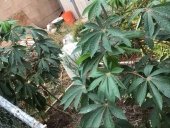
 9
9




-trish
“If you have a garden and a library, you have everything you need” (Cicero)
“But also, biscuits!”
(Trish)
 5
5




Creating sustainable life, beauty & food (with lots of kids and fun)
 2
2




-trish
“If you have a garden and a library, you have everything you need” (Cicero)
“But also, biscuits!”
(Trish)
 8
8




Jim Fry wrote:First year root too small. Second year root good to use. Third year and older roots, not much good at all.
 3
3




Invasive plants are Earth's way of insisting we notice her medicines. Stephen Herrod Buhner
Everyone learns what works by learning what doesn't work. Stephen Herrod Buhner
 9
9




 8
8




 8
8




 5
5




 4
4




Ellen Lewis wrote:I can't imagine burdock doing any harm to fruit trees.
 6
6





 5
5




Ellen Lewis wrote:I love the roots pickled in nuka (rice bran). I bet they're good as a miso pickle...

|
There's a way to do it better - find it. -Edison. A better tiny ad:
Learn Permaculture through a little hard work
https://wheaton-labs.com/bootcamp
|



